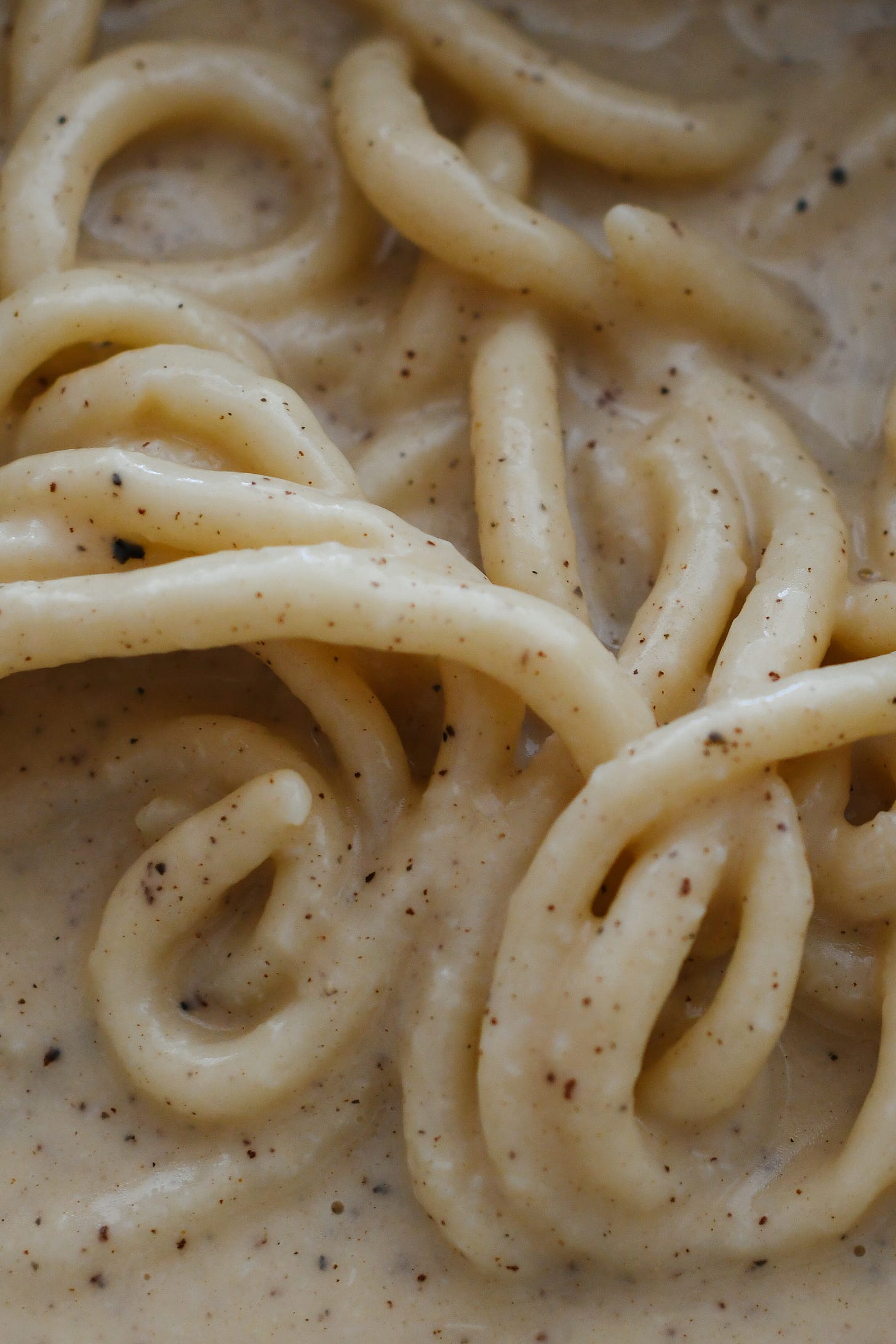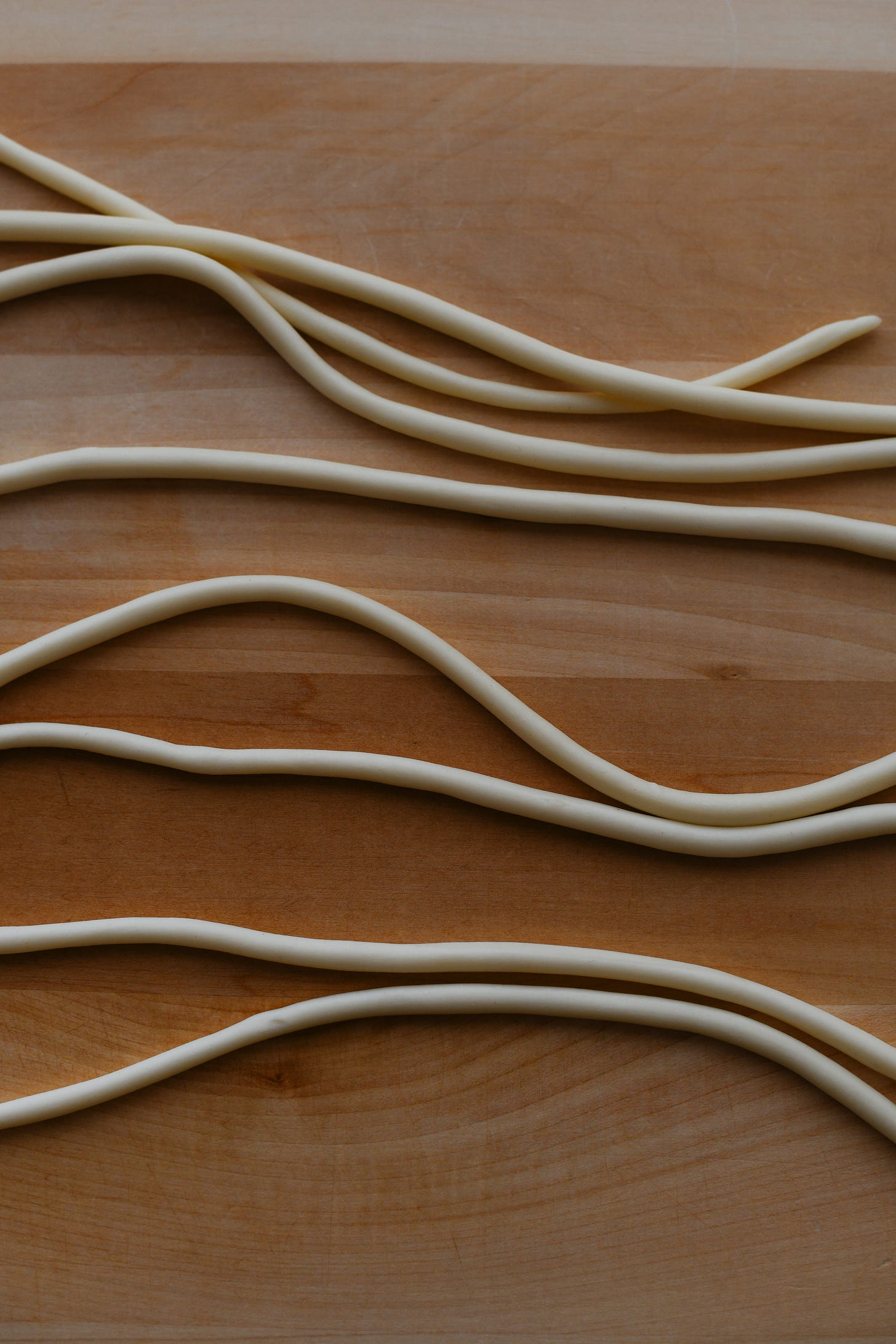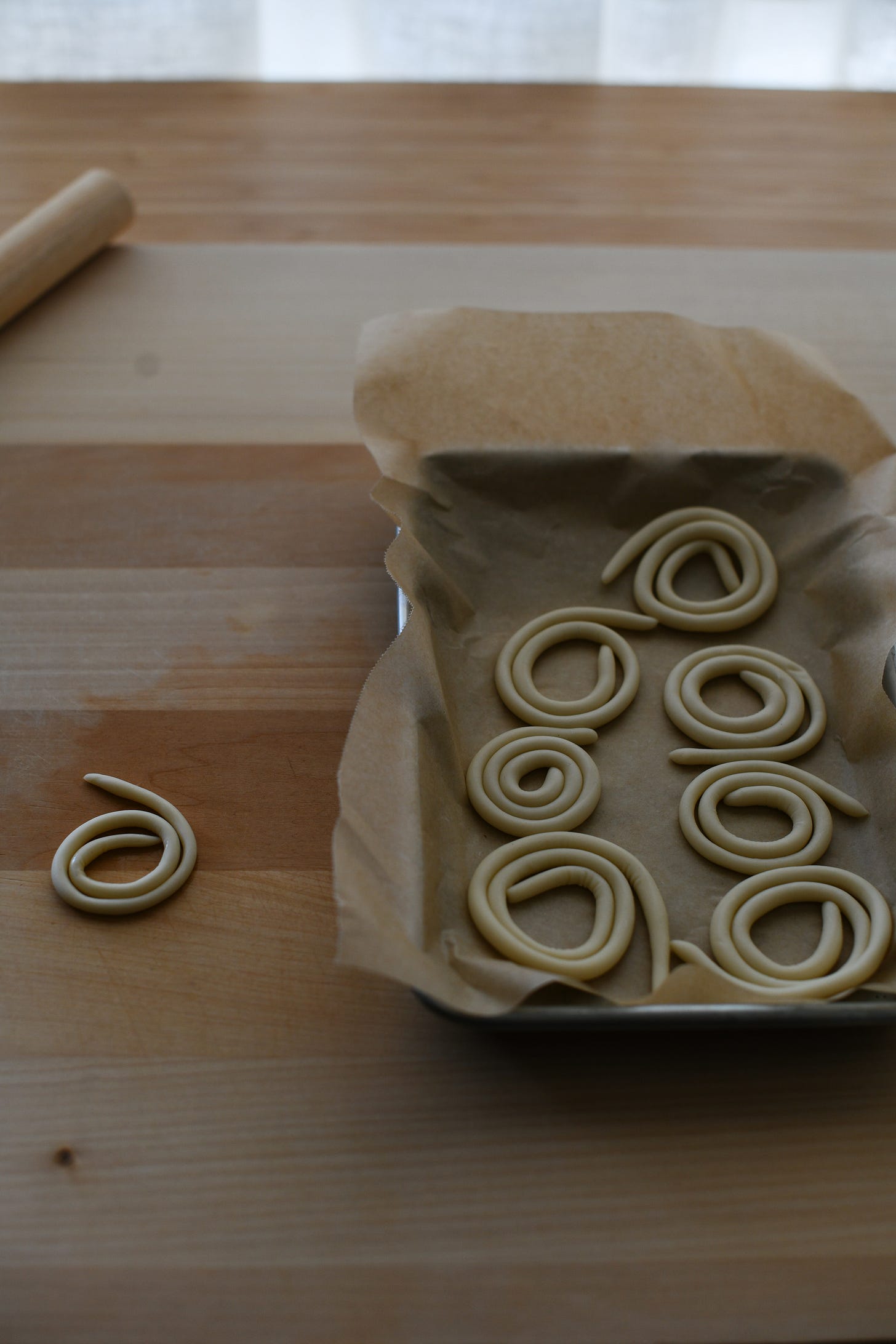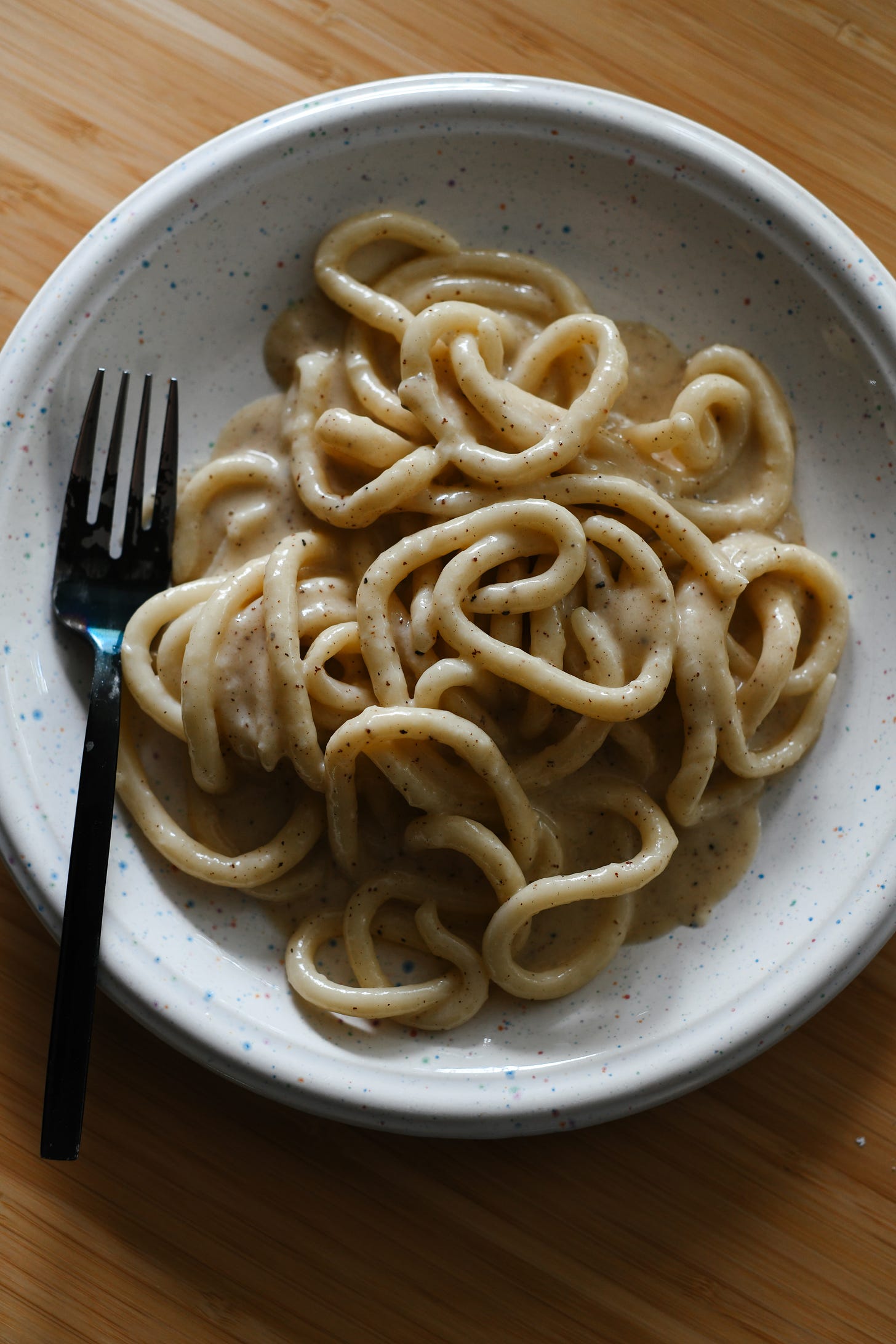Hi friends! Happy Sunday and welcome back to this week’s instalment of Pasta Sunday. Today we are making pici, a rustic, hand-formed fat spaghetti-type shape and one of my all time favourites to make and eat because of its ability to be both chewy and slurpy at the same time. We’re pairing it with a criminally saucy and non-traditional take on the beloved cacio e pepe - using butter as our friend to both emulsify, stabilise and add a lovely nutty note to the finished plate.
Before we get into it, if you want to see how I make a classic cacio e pepe sauce and hear a very old voice over (cringe), check this video out.
ANYWHO - off we go.
Let’s start with today’s shape - pici! Pronounced pea-chee :) also known as lunghetti, strangozzi, pinci, and umbricelli (Lazio/Umbria). This shape typically hails from Tuscany (specifically southern Tuscany and the provinces of Siena and Val di Chiana), but also in Umbria and Lazio under a different name as noted above.
Pici is characterised by it’s irregular shape - truly a rustic hand-formed pasta! However you’ll notice I like to make mine quite uniform and smooth - I say this is really down to preference. Basically, don’t sweat it if yours look a bit uneven.
Perhaps it is this rustic and imperfect quality that popularised pici as a fresh pasta option in restaurants. Over the past few years I have noticed pici popping up on menus all over the place and aside from the fact it’s a true joy to eat, the ability to make it quickly and without a huge amount of effort is likely what put it there. Sometimes I find the rustic quality has been taken too far, finding overly fat and almost haphazardly shaped pasta that I just don’t enjoy. But again, that’s preference!
Pici is probably one of the first hand-formed shapes I made way back when I started on this pasta journey. It’s the perfect beginner’s shape because all it takes is a simple flour/water dough, and using your hands as tools to shape the strands. To make it we start with a 45-47% hydrated dough comprised of water and tipo 00 flour. You can absolutely make this with semola or a mix of the two, but it will result in a slightly denser and chewier pasta once cooked.
Once the dough is formed, a long rest is required. If you want to really elongate those strands and achieve uniformity and a little finesse on the thickness of it, then we ideally want to rest the dough for a min of 60 minutes. This will allow the gluten in the pasta to develop and relax, and support the pliability of the dough and in turn your ability to manipulate it. A little olive oil is also introduced, brushed over the dough to make up a bit of hydration, help with shaping, but most importantly to prevent the strands from drying out and sticking together.
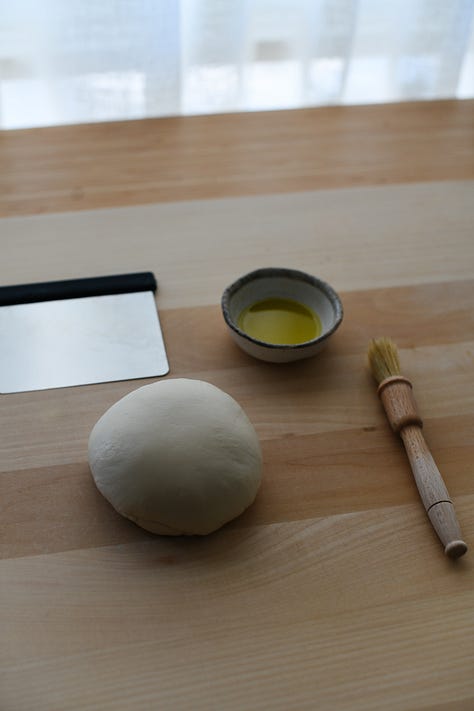
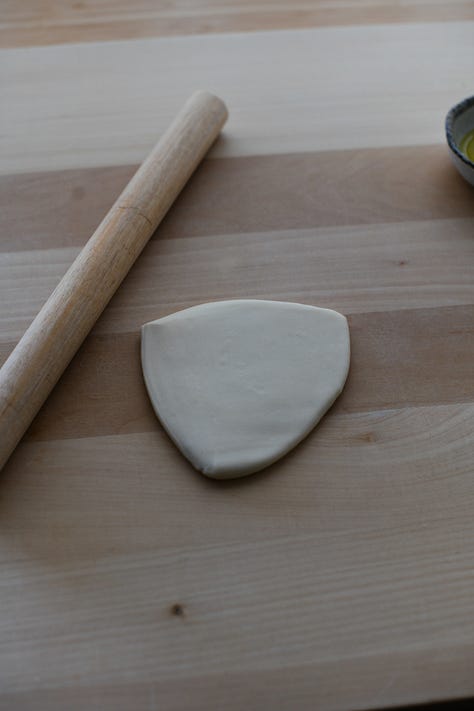
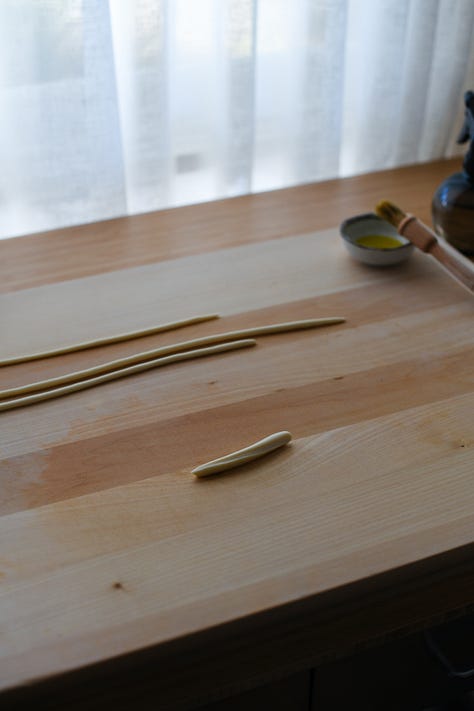
A note on storage: I get asked about how to store fresh pasta all the time. While I think fresh pasta is often best used right away, the reality is I often make pasta ahead of time to cook later on - especially since having my daughter and finding I don’t have a lot of time to make pasta and cook in one go.
My favourite way to store pici is by rolling into a spiral, the flash freezing on a baking sheet. After 20 minutes, the coils can then be placed into an airtight container or ziplock and stored in the freezer. Cook directly from frozen, but be mindful they will need a little longer to cook from frozen.
You can check out a video of me making pici here, for all the visual learners out there!
Now that we’ve tackled the shape, let’s chat about the sauce. Cacio e pepe is one of the iconic Roman classics and quite literally translates to cheese (cacio) and pepper (pepe). I once read this dish was created by shepherd’s, being able to carry these few ingredients with them (pasta, cheese, pepper) that would keep well - perfect for their roaming and herding lifestyles. And so the traditional and original way of preparing this is just by using the pasta’s cooking water to create a creamy emulsion. It sounds simple, but it is probably one of the trickier dishes to nail. Enter butter.
Butter has become a popular addition to this dish because of its ability to better support a creamy emulsion. It also adds a softer more - well - buttery flavour to this dish, which to be honest, I often welcome. Adding butter to this dish arguably makes it that little bit more decadent, but also acts as a bit of a safeguard to prevent a stringy and clumpy sauce.
The recipe below is ultra-saucy, just how I like it. However you could easily stretch this for four serves - just increase the amount of pasta you make and you’ll achieve a slightly lighter coating of sauce.
I originally developed this recipe for Small Pleasures and their coffee/conversations series. You can find the interview here.
The Recipe
Serves 2 - big portions! Go big or go home
Ingredients
For the pici
200g tipo 00 flour
90-94ml warm water
10ml EVOO
For the sauce
1 tablespoon black peppercorns
100g unsalted butter
150g Pecorino Romano, as finely grated as possible
Method
Place the flour in a mound on your work surface and create a well in its centre. Pour in the water and whisk in small amounts of flour until you have a paste, then continue to add flour to this mix and cut it in with a bench scraper or your fingers.
Bring the dough together to form a shaggy ball, then knead for 7-10 minutes with a short, covered rest halfway until your dough ball is smooth, elastic and springs back when poked. Cover and rest for a minimum of 30 minutes but preferably 60 minutes.
Divide the dough into four pieces. Work with one at a time while keeping the other pieces covered so they don't dry out. Using a rolling pin, flatten the piece until it's about 1-2cm thick. Brush each side with olive oil, then cut into strips around 1cm in width.
Using the palms of your hands roll each strip out into a long, round noodle. Start with your hands in the centre then work them outward, stretching the dough into a thick noodle (or spaghettoni). Keep going until your noodle is about 1/2 cm thick. Pici is a rustic shape, and irregularities are the beauty of hand rolled pasta!
Set each noodle aside on a baking sheet lined with fine semolina or a clean tea towel while you continue with the rest of the dough.
To make the sauce, first bloom the peppercorns by gently heating in a dry pan until fragrant. Transfer to a mortar and pestle and grind until coarse.
Heat the butter in a pan and brown. It’ll splutter and foam and smell wonderfully nutty - swirl the pan frequently to prevent burning. Once the sputtering sound suddenly comes to a halt, your butter should be nicely browned. Add 1 teaspoon of the ground black pepper and allow this to cook momentarily before removing from the heat. Set aside while you cook the pici, which you do so by boiling in generously salted water for 4-5 minutes depending on how thick you’ve rolled them.
Once the pici is al dente, put the brown butter back on a low heat and add the pasta directly to it. Toss well and add a splash more pasta water to create a base for the cheese emulsion. Add the finely grated Pecorino Romano by the handful and quickly agitate the pan, stirring, whirling and tossing vigorously to create a creamy sauce. Add pasta water as needed if this feels too thick and coagulated, or if you add too much you can add some extra grated Pecorino to thicken.
Serve immediately and enjoy!




